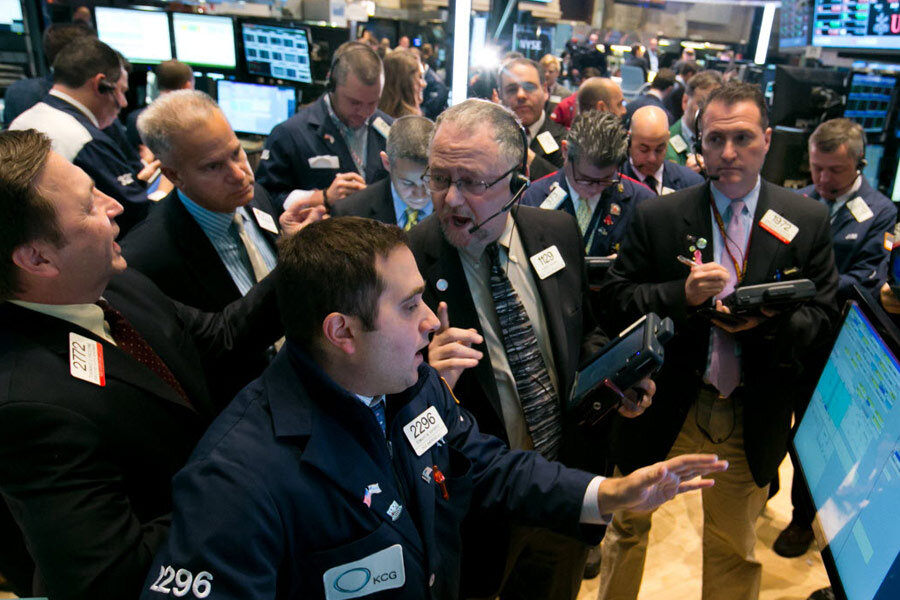Stock market jitters: After last year's record run, are you surprised?
Loading...
| New York
After the record-smashing performance of the stock market last year, this year’s Wall Street volatility might not come as much of a surprise.
Awash in cheap and easy cash as the Federal Reserve propped up markets with its $85-billion-a-month stimulus program – the quantitative easing that kept interest rates next to nothing – stocks staged one of the biggest rallies in history over the last five years, even as the economy lumbered forward at a much more tepid pace.
But now that the Fed has begun its long-awaited “taper,” investors may be losing their security blanket, and many have begun to wonder whether the markets’ historic gains can carry over to this year. Some worry, too, that these eye-popping numbers indicate a market bubble, prompting a 2014 correction that will bring it more in line with actual productivity and economic outputs.
“The Fed has essentially pushed forward investment returns,” says Josh Strauss, portfolio manager of Appleseed Fund in Chicago. “And as a result, we think that both the stock and the bond markets are overvalued right now, overall.”
So far, each major market index has lost some of its 2013 gains amid global volatility and less-than-comforting economic news. The S&P 500 closed at 1751.47 on Wednesday, a decline of 5.23 percent for the year, while the Dow closed at 15,440.23 – a loss of over 1100 points in 2014, or almost 7 percent of its 2013 value.
Much of these losses stemmed from the pressures on the currencies of emerging markets across the globe – markets that during the economic crisis were relatively robust. Money poured into these economies the last five years, but last week investors yanked $6.3 billion out of developing-nation stocks and bonds, the biggest outflow since August 2011, according to Bloomberg.
“So it’s quite amazing, as you really think about it, the Fed itself was not only propping up domestic markets, but also, we’re learning now with the rout in the emerging markets, that they were also helping and propping up these emerging markets,” says Mark Williams, a former Federal Reserve bank examiner who teaches risk management at Boston University’s School of Management.
Currencies are weakening in what is being called the “fragile five” of the world’s emerging markets – those in Brazil, Turkey, South Africa, India, and Indonesia. As the Fed eases back on its stimulus, these countries have been forced to raise their interest rates – which in turn has dampened their economic growth.
“These emerging markets were big beneficiaries of cash flows when rates were low and the Fed was printing money,” says Mr. Strauss. “And so you’re seeing big currency movements in basically every currency around the world – which has had the compounded effect on the rate of return in the stock market, in US dollar terms.”
Add to these the current problems in China, which saw its manufacturing slow to a six-month low in January.
“I was really struck by a meeting I had with central bankers in Chile in Santiago this summer,” recalls Williams. “And we were around the table, and I asked them what kept them up at night. What they said was, well, we’re worried about China. Our biggest export is copper, and China, they’re our biggest buyer.”
“Now China has to clean up its act, and that hasn’t been a transparent market,” says Williams. “So we don’t know how bad the banks are, or when the government is going to get more aggressive at requiring banks to account for the true losses, and true-up their books, so to speak.”
But if these global currency problems were central to this week’s market stumbles, there are other disturbing domestic trends, some analysts say.
For one, interest rates have been declining for the past few decades, and they will eventually start to tick up again after the Fed’s stimulus comes to an end, putting pressure on corporate profit margins.
And so far this year, 44 S&P 500 companies are forecasting lower-than-expected earnings this year, while only 10 have increased their 2014 outlooks, according to data from FactSet. Many analysts also expect countries to close tax loopholes for corporations in the coming months and years, putting more pressure on earnings.
The US economy remains relatively sluggish as well. Only 74,000 new jobs were created in December – far less than expected – and a survey of US manufacturers also revealed far less activity than analysts thought, though much of this has been attributed to the cold weather.
All of this might make investors more skittish on stocks in the coming year.
“Typically, in an uncertain market, money flows directly to fixed income,” says Williams. But the bond market has been one of the worst in decades. Last year was only the third time in 34 years that bond assets posted an overall loss. The safe bet, ironically, has been in stocks during the market’s recent run.
“I think that, on the one hand, investors were thinking that the Fed has got their back, and in the US that’s been the case for the last 5 years,” says Strauss. “But the fixed income markets are pretty unattractive. After a 30-year bull market in bonds, this is the first year in a long, long time that we’ve had a negative rate of return in the bond market” – the first time it ended the year in the red since 1999.
Even so, the stimulus is only being tapered by $10 billion a month, which will keep the easy money spigot open for the time being.
“And there was enough good economic news over the last six months, so investors are still feeling that they can stretch out a bit, and dip more than their toe in the water,” says Williams.
“And these returns have just been wonderful,” he continues. “Wall Street is having a wonderful bonus year. So, you know, they’re still pretty giddy.”








